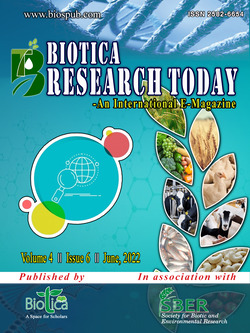
Suppression of Plant Diseases by Exploiting Spent Mushroom Substrate
D. Mahato
Dept. of Plant Pathology, Institute of Agricultural Sciences, Siksha-O-Anusandhan (Deemed to be University), Bhubaneswar, Odisha (751 003), India
DOI: NIL
Keywords: Beauveria bassiana, Pseudomonas fluorescens, Spent mushroom substrate, Trochoderma spp.
Abstract
The substrate released following mushroom crop harvest, more often referred to as “SMS”, is also of critical importance. It is an organically rich substrategenerated in vast quantities, around five times that of fresh mushrooms has the capacity to complement the nutritional needs of agricultural plants while also safeguarding them from various insect pests and diseases due to its physical, chemical, and microbiological qualities, if handled appropriately. It has the ability to bio-remediate soils that have been damaged with pesticides and heavy metals in excess. In this sense, it has the ability to defend plants in a multifaceted manner, with its nutritional richness supporting plant development while chemical contents and microbial components simultaneously activate the plant defence system or exhibit antagonism. The SMS's recycling backend provides an environmentally friendly option for growing high-quality crops as well as a long-term waste management solution, resulting in a comprehensive contribution to agriculture's long-term progress.
Downloads
not found
Reference
Ahlawat, O.P., Kumar, S., Sharma, P., 2022. Spent mushroom substrates (SMS) - a potential source of bio-agents for plant diseases management. In: Compendium of Mushroom Diseases. Edition 1st, Chapter: 12. Indian Phytopathological Society, Division of Plant Pathology, IARI, New Delhi, pp. 108-124.
Fujita, R., Yokono, M., Ube, N., Okuda, Y., Ushijima, S., Fukushima-Sakuno, E., Ueno, K., Osaki-Oka, K., Ishihara, A., 2021. Suppression of Alternaria brassicicola infection by volatile compounds from spent mushroom substrates. Journal of Bioscience and Bioengineering 132(1), 25-32.
Zepeda-Bastida, A., Ojeda-Ramírez, D., Soto-Simental, S., Rivero-Perez, N., Ayala-Martínez, M., 2016. Comparison of antibacterial activity of the spent substrate of Pleurotus ostreatus and Lentinula edodes. Journal of Agricultural Science 8(4), 43. DOI: https://doi.org/10.5539/jas.v8n4p43.
